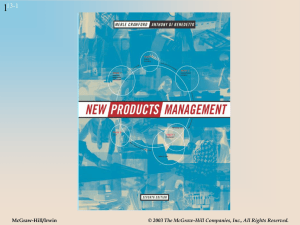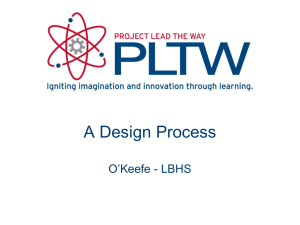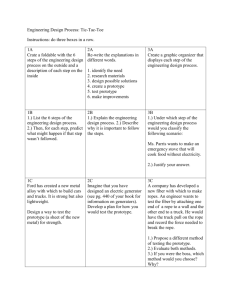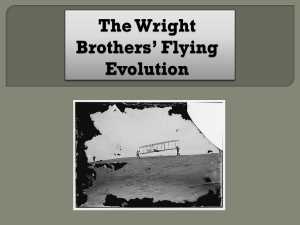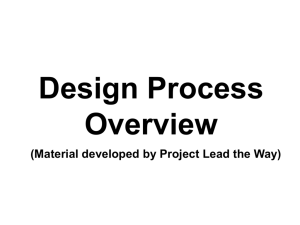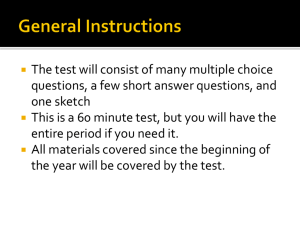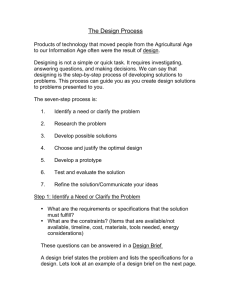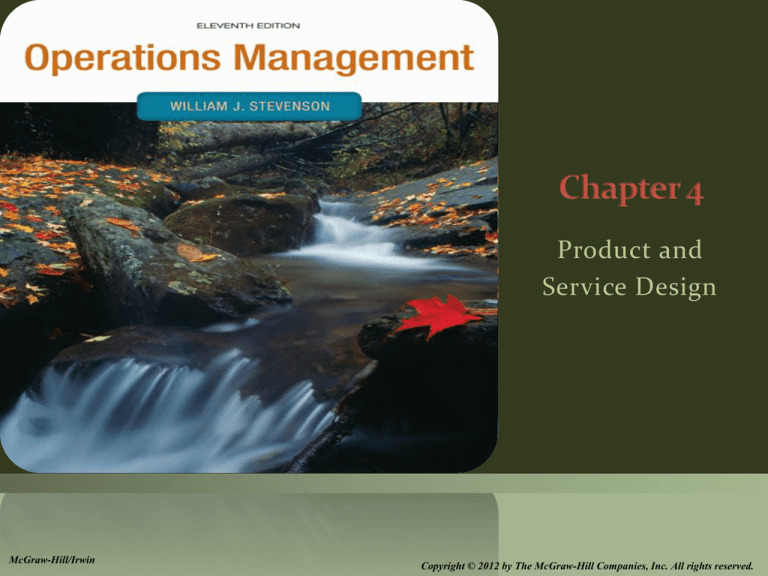
Product and
Service Design
McGraw-Hill/Irwin
Copyright © 2012 by The McGraw-Hill Companies, Inc. All rights reserved.
You should be able to:
1.
Explain the strategic importance of product and service design
2. Identify some key reasons for design or redesign
3. Recognize the key questions of product and service design
4. List some of the main sources of design ideas
5. Discuss the importance of legal, ethical, and sustainability
considerations in product and service design
6. Explain the purpose and goal of life cycle assessment
7. Explain the phrase “the 3 Rs”
8. Briefly describe the phases in product design and development
9. Name several key issues in manufacturing design
10. Recognize several key issues in service design
11. Name the phases in service design
12. List the characteristics of well-designed service systems
13. Assess some of the challenges of service design
Student Slides
4-2
The essence of an organization is the goods and services it
offers
Every aspect of the organization is structured around
them
Product and service design – or redesign – should be
closely tied to an organization’s strategy
Student Slides
4-3
Stages of product/service design:
Functional design (form, shape, size, materials,
etc.)
Process design (processing technology and
tooling)
Production design (production line & plant
layout)
Product/service quality
Production/delivery cost
Customer satisfaction
1.
Is there a demand for it?
Market size
Demand profile
2.
Can we do it (competence)?
Manufacturability - the capability of an organization to
produce an item at an acceptable profit
Serviceability - the capability of an organization to provide
a service at an acceptable cost or profit
3.
What level of quality is appropriate?
Customer expectations
Competitor quality
Fit with current offering
4.
Does it make sense from an economic standpoint?
Liability issues, ethical considerations, sustainability issues,
costs and profits
Student Slides
4-6
Developing New Products/Services
Sources of Product Innovation
Getting Them to Market Faster
Designing and Developing New Services
Improving Current Products/Services
Designing for Ease of Production
Designing for Quality
Customers
Managers
Marketing
Operations
Engineering
Research and Development (R&D)
Basic research
Applied research
1. Technical and economic feasibility studies
2. Prototype design
3. Performance testing of prototype
4. Market sensing/evaluation and economic evaluation
of the prototype
5. Design of production model
6. Market/performance/process testing and economic
evaluation of production model
7. Continuous modification of production model
1. Technical and Economic Feasibility Studies
Determine the advisability of establishing a project for
developing the product
If initial feasibility studies are favorable, engineers
prepare an initial prototype design
2. Prototype Design
This design should exhibit the basic form, fit, and
function of the final product
It will not necessarily be identical to the production
model
3. Performance Testing of Prototype
Performance testing and redesign of the prototype
continues until this design-test-redesign process
produces a satisfactorily performing prototype
4. Market Sensing/Evaluation and Economic
Evaluation of the Prototype
Accomplished by demonstrations to potential
customers, market test, or market surveys
If the response to the prototype is favorable, economic
evaluation of the prototype is performed to estimate
production volume, costs, and profits
If the economic evaluation is favorable, the project
enters the production design phase.
5. Design of Production Model
The initial design of the production model will not be
the final design; the model will evolve
6. Market/Performance/Process Testing and
Economic Evaluation of Production Model
The production model should exhibit:
low cost
reliable quality
superior performance
the ability to be produced in the desired quantities on the
intended equipment
7. Continuous Modification of Production Model
Production designs are continuously modified to:
Adapt to changing market conditions
Adapt to changing production technology
Allow for manufacturing improvements
About 5% of all new-product ideas survive to
production, and only about 10% of these are
successful.
It is best to cancel unpromising newproduct/service development projects early!
Employees often become emotionally caught up
in these projects and are overly optimistic
An impartial management review board is needed
for periodic reviews of the progress of these
projects.
Speed creates competitive advantages
Speed saves money
Tools to improve speed:
Autonomous design and development teams
Computer-aided design/computer-aided
manufacturing (CAD/CAM)
Simultaneous (concurrent) engineering
Autonomous Design and Development Teams
Teams are given decision-making responsibility and
more freedom to design and introduce new
products/services
Time-to-market has been slashed dramatically
Enormous sums of money have been saved
Teams do not have to deal with the bureaucratic red tape
ordinarily required to obtain approvals
Computer-Aided Design/Computer-Aided
Manufacturing (CAD/CAM)
Engineers, using CAD/CAM, can generate many views of
parts, rotate images, magnify views, and check for
interference between parts
Part designs can be stored in a data base for use on other
products
When it is time for manufacturing, the product design is
retrieved, translated into a language that production
machinery understands, and then the production
system can be automatically set up.
Simultaneous
(Concurrent)
Engineering
Product/
Service Ideas
Economic and Technical
Feasibility Studies
Product/Service Design
Continuous
Interaction
Production Process Design
Produce and Market
New Product/Service
Focus is improving performance, quality, and cost
Objective is maintaining or improving market
share of maturing products/services
Little changes can be significant
Small, steady (continuous) improvements can add
up to huge long-term improvements
Value analysis is practiced, meaning design
features are examined in terms of their
cost/benefit (value).
Ease of Production (Manufacturability)
Specifications - Precise information about the
characteristics of the product
Tolerances - Minimum & maximum limits on a dimension
that allows the item to function as designed
Standardization - Reduce variety among a group of
products or parts
Simplification - Reduce or eliminate the complexity of a
part or product
Crucial element of product design is its impact on
quality
Quality is determined by the customer’s
perception of the degree of excellence of the
product/service’s characteristics
Chapter 7 covers the principles of designing
products/services for quality
Three general dimensions of service design are:
Degree of Standardization of the Service
Custom-fashioned for particular customers or basically
the same for all customers?
Degree of Customer Contact in Delivering the
Service
High level of contact (dress boutique) or low level (fast-
food restaurant)?
Mix of Physical Goods and Intangible Services
Mix dominated by physical goods (tailor’s shop) or by
intangible services (university)?
Differences Between New Service and New
Product Development
Unless services are dominated by physical goods, their
development usually does not require engineering,
testing, and prototype building.
Because many service businesses involve intangible
services, market sensing tends to be more by surveys
rather than by market tests and demonstrations.
Legal considerations
Ethical considerations
Human factors
Cultural factors
Global product and service design
Environmental factors
Others
Student Slides
4-27
Sustainability
Using resources in ways that do not harm ecological systems that
support human existence
Key aspects of designing for sustainability
Cradle-to-grave assessment (Life-Cycle assessment)
End-of-life programs
The 3-Rs
Reduction of costs and materials used
Re-using parts of returned products
Recycling
Student Slides
4-28
Value analysis
Examination of the function of parts and materials in an effort to
reduce the cost and/or improve the performance of a product
Common questions used in value analysis
Is the item necessary; does it have value; could it be eliminated?
Are there alternative sources for the item?
Could another material, part, or service be used instead?
Can two or more parts be combined?
Can specifications be less stringent to save time or money?
Do suppliers/providers have suggestions for improvements?
Can packaging be improved or made less costly?
Student Slides
4-29
Remanufacturing
Refurbishing used products by replacing worn-out or defective
components
Can be performed by the original manufacturer or another company
Reasons to remanufacture:
Remanufactured products can be sold for about 50% of the cost of a
new product
The process requires mostly unskilled and semi-skilled workers
In the global market, European lawmakers are increasingly requiring
manufacturers to take back used products
Design for disassembly (DFD)
Designing a product to that used products can be easily taken apart
Student Slides
4-30
Recycling
Recovering materials for future use
Applies to manufactured parts
Also applies to materials used during production
Why recycle?
Cost savings
Environmental concerns
Environmental regulations
Companies doing business in the EU must show that a specified
proportion of their products are recyclable
Design for recycling (DFR)
Product design that takes into account the ability to
disassemble a used product to recover the recylcable parts
Student Slides
4-31

